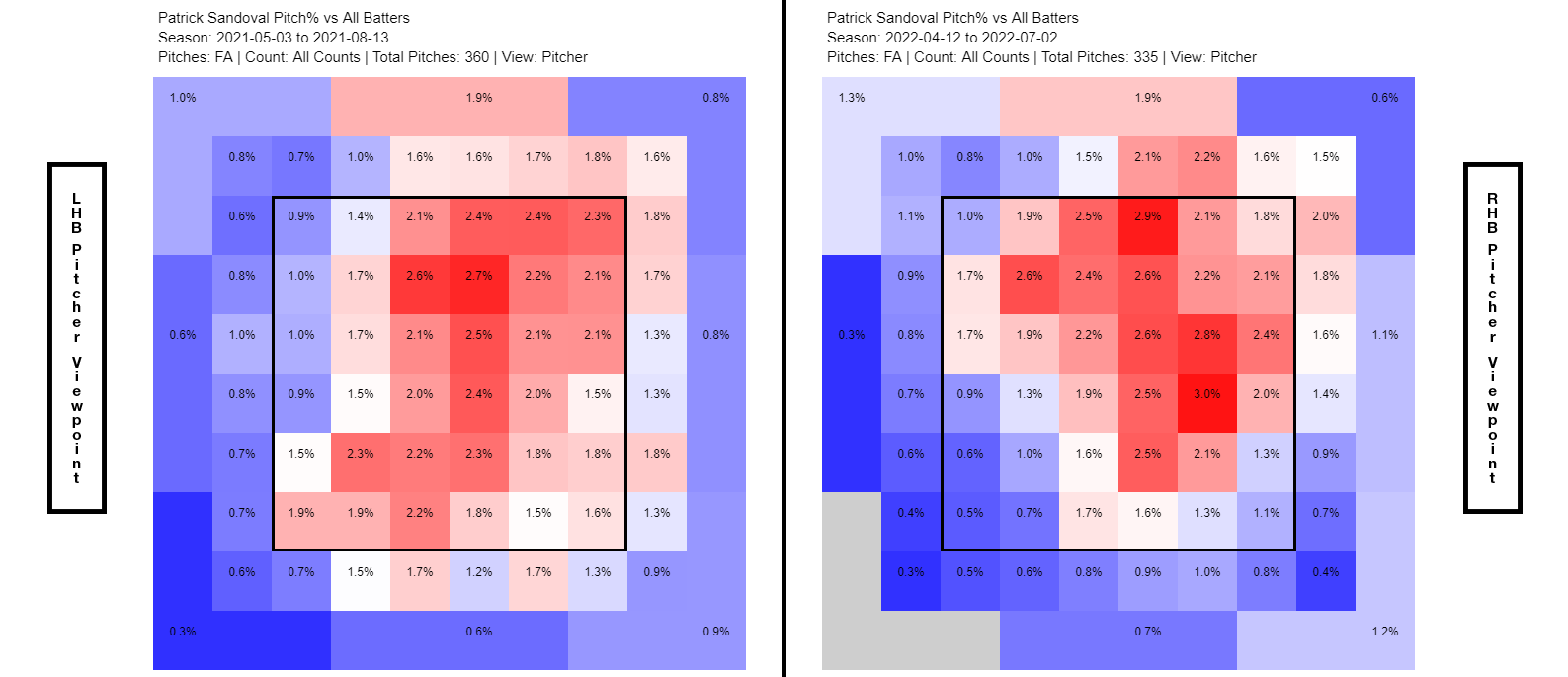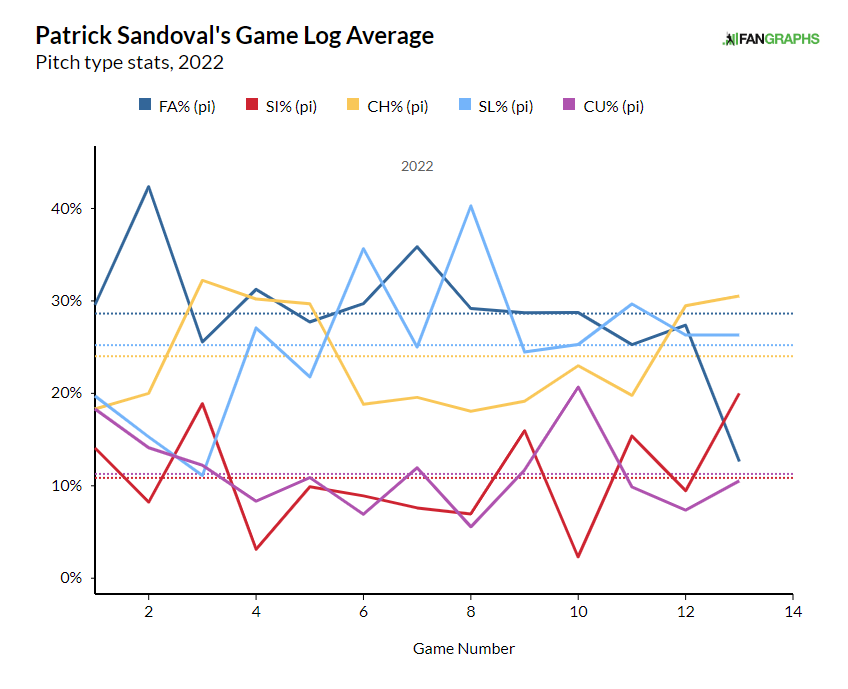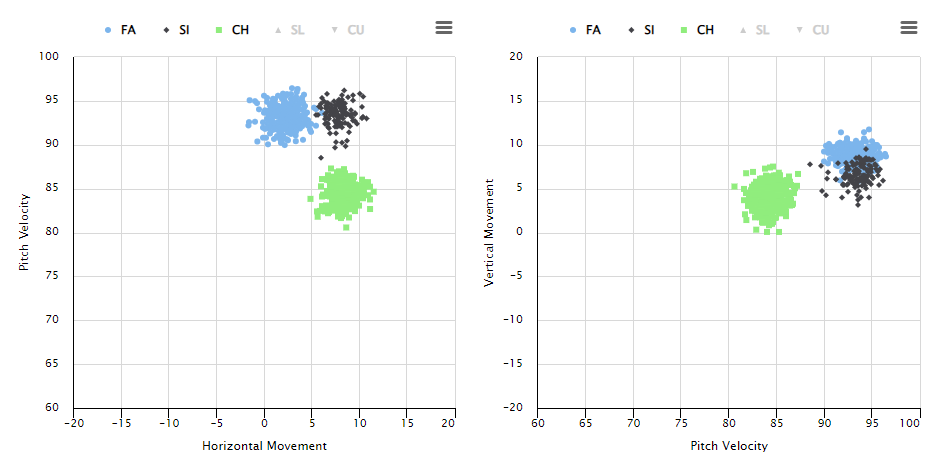Patrick Sandoval Has a Fastball Problem

Last year, Patrick Sandoval broke out in a big way, posting career-bests in ERA, FIP, strikeout rate, called and swinging strike rate, and WAR. The foundation of his newfound success was a phenomenal changeup that was among the most effective pitches in all of baseball. This season, he’s lowered his ERA and FIP by more than half a run apiece, and has been the Angels second-most valuable starter behind Shohei Ohtani. Still, his strikeout rate has fallen by a couple of points even though his change has been as effective as it was last year. Looking past that one standout pitch, it’s clear Sandoval is being held back by another aspect of his arsenal: his fastballs.
Sandoval throws two different types of heaters and neither is all that effective. Last year, he allowed a cumulative .356 wOBA off his two fastballs; that mark is up to .408 this season. It’s a stark contrast to his three secondary offerings, which are all whiff machines. Here’s a look at his per pitch type results from this year:
| Pitch Type | Whiff% | GB% | Hard Hit% | wOBA | xwOBAcon |
|---|---|---|---|---|---|
| Four-seam | 7.5% | 39.1% | 39.1% | .476 | .447 |
| Sinker | 10.9% | 51.9% | 29.6% | .238 | .285 |
| Changeup | 48.0% | 47.6% | 28.6% | .232 | .433 |
| Slider | 38.5% | 46.7% | 31.7% | .217 | .378 |
| Curveball | 39.1% | 55.6% | 22.2% | .461 | .329 |
Among all four-seam fastballs thrown at least 100 times this year, Sandoval’s whiff rate of 7.5% is the second lowest in baseball. His sinker’s whiff rate is a little better at 10.9%, but still below average for that pitch type. On the other hand, his changeup and two separate breaking balls each have whiff rates no lower than 38.5%. For Sandoval, it’s feast or famine depending on which pitch in his arsenal he’s throwing.
So what makes his hard stuff, and his four-seamer in particular, so ineffective? It begins with their shape and physical characteristics. Here’s a look at his two fastballs, with each pitch’s percentile ranks when compared with their respective pitch types:
| Pitch Type | Velocity | V Mov | H Mov | Spin Rate | Active Spin | Spin Axis | Spin Deviation |
|---|---|---|---|---|---|---|---|
| Four-seam | 93.0 (35) | 15.3 (46) | 4.0 (16) | 2045 (6) | 86% (28) | 11:15 | -15 (83) |
| Sinker | 93.2 (50) | 19.0 (23) | 14.1 (30) | 1927 (7) | 86% (35) | 11:15 | 60 (67) |
The first thing that jumps out is the extremely low raw spin rate and well below-average active spin rate on both of Sandoval’s fastballs. The prototypical, modern four-seamer has both a high raw spin rate and a high active spin rate, producing tons of backspin, which imparts riding vertical movement to the pitch. Some pitchers can get away with a lower raw spin rate if their backspin is pure, leading to proportionally more spin directly affecting the pitch’s movement profile. Sandoval’s fastballs don’t fit this model, making them a bit of an outlier. The movement profile of his four-seamer is rather lackluster, with an average amount of ride and hardly any horizontal cut. It’s a straight fastball in the worst sense.
Part of the problem with Sandoval’s four-seamer is where he’s locating it. He likes to throw it up in the zone, acting as though it’s a riding fastball. Because the pitch doesn’t have the physical characteristics to be as effective in those locations, if he’s not precise with his command, he’s prone to giving up loud contact off it. He’s actually throwing up in the zone more often this year, too:

Last year, his four-seamer was a bit more effective, with a 17.6% whiff rate and a .358 wOBA against — both marks below average for the pitch type but better than what he’s accomplished this season. One of the reasons Sandoval was more successful with this pitch in 2021 was because he threw it down in the zone far more often. That allowed him to induce far more groundballs when batters made contact. And because he wasn’t trying to force his straight fastball into locations where it can’t be as effective because of its physical characteristics, he found a bit more success with it.
His sinker is a bit more interesting. It doesn’t drop off the table, but it does have the telltale arm-side fade, even if the raw horizontal movement on the pitch isn’t all that impressive comparatively. What it does have going for it is a significant amount of spin deviation, likely caused by seam shifted wake effects, as the pitch is thrown with the same initial spin axis as his four-seamer but has 10 inches of additional arm-side break to it. While that spin deviation hasn’t necessarily resulted in a ton of swings and misses on his sinker, it provides enough deception to significantly reduce the amount of hard contact given up on the pitch when it’s put in play. Look back at that first table above; Sandoval’s sinker possesses the lowest expected wOBA on contact of the five pitches in his arsenal.
With all that in mind, perhaps the best course of action for Sandoval would be to ditch his four-seamer and focus solely on his sinker as his primary fastball. That’s exactly what he did in his last start against the Astros on July 2.

Just 12.6% of his pitches in that start were four-seam fastballs, the lowest rate of his career outside of a three-game stretch in May 2021 when Sandoval exclusively threw sinkers while pitching out of the bullpen. He didn’t generate any called or swinging strikes with his four-seamer in that start, but his sinker was particularly effective, with a 38% whiff rate. His final line was a mixed bag; his nine strikeouts tied a season high but he allowed five runs on eight hits and two walks in just five innings. Considering the opponent, that’s not all that bad.
But Sandoval can’t simply switch the usage of his four-seamer and sinker; a change like that would certainly have knock-on effects for the rest of his arsenal. Curiously, Sandoval’s changeup almost exactly mirrors the shape of his sinker, only it comes in almost 14 mph slower.

It might be reasonable to assume that Sandoval’s changeup would be just as effective playing off his sinker as it is playing off his four-seamer. The velocity differential would remain the same and the movement mirroring would add an extra bit of deception to an already effective pitch. Of course, pairing those two pitches would make facing him simply a matter of timing, instead of both timing and recognizing two different pitch shapes.
What’s more, his two breaking balls are extremely effective in their own right. Simply cutting down the total number of fastballs in his pitch mix could prove to be just as effective as focusing on his sinker over his four-seamer. Research has shown that increasing a pitch’s usage doesn’t necessarily affect its overall effectiveness. Sandoval could simply decide to lean on his three secondary offerings a lot more often and he’d probably see an uptick in results.
Sandoval currently has little motivation to make sweeping changes to his pitch mix. His ERA and FIP are at career-lows and he’s proven that his breakout year last season was no fluke. But he’s pitching with razor thin margins right now despite possessing a deadly changeup that’s one of the best pitches in the league. His xFIP is nearly a full run higher than his ERA because he’s allowed just four home runs all season long. Opposing batters are simply crushing his four-seam fastball and he’s been extremely lucky that more of those balls in play haven’t flown over the fence. The slight change in pitch mix in his last start was a good beginning point. If he can find some consistency with his sinker as his primary fastball while still leaning on his three secondary offerings as out pitches, he could take a significant step forward during the second half of the season. That would be a huge boon to an Angels team that’s desperate for a spark.
Jake Mailhot is a contributor to FanGraphs. A long-suffering Mariners fan, he also writes about them for Lookout Landing. Follow him on BlueSky @jakemailhot.

If he stops throwing the 4S then his walks will probably rise a lot. A sinker/change pitcher has to live in the bottom of the zone since those pitches don’t work well in the upper half, and it makes it easier to lay off of them. You can succeed that way; Framber Valdez certainly does OK with it. But the tradeoff is increased walk rate, which Sandoval already struggles with.
Is there evidence that pitchers walk more batters when they rely on the sinker/change combo, or is it your opinion? I’m not aware of any studies connecting pitch type with walk rate after a change in pitch mix – would be really interesting to see something along those lines though!